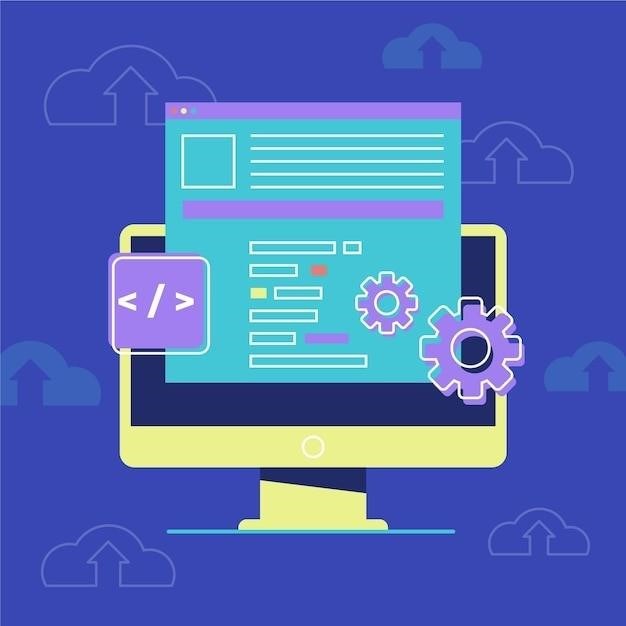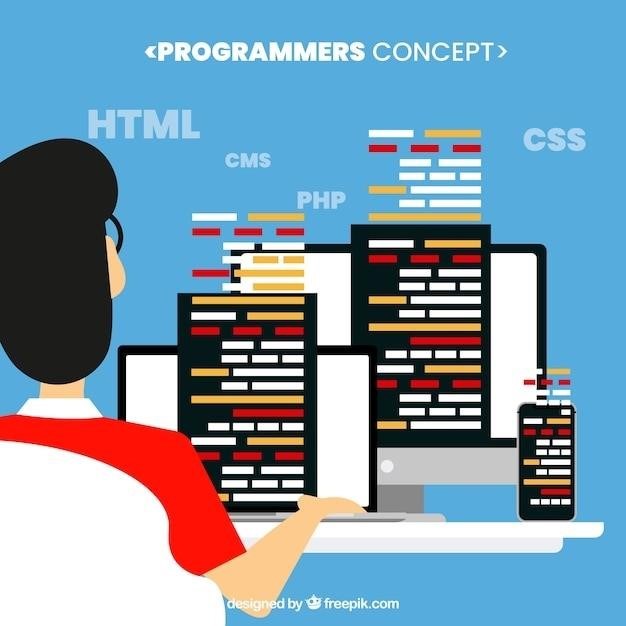Finding JavaScript Programming Language PDFs Online
Numerous online resources offer JavaScript programming language PDFs. These range from beginner-friendly tutorials to advanced guides covering complex concepts and techniques. Reliable sources include established educational platforms, developer communities, and individual authors sharing their work. Free and paid options are widely available, catering to various learning styles and skill levels. Look for PDFs with clear explanations, practical examples, and community support for optimal learning.
Reliable Sources for JavaScript eBooks
Several reputable sources provide high-quality JavaScript eBooks in PDF format. Established online learning platforms, such as those offering courses on web development, often make their course materials available as downloadable PDFs. These platforms usually ensure quality control and provide structured learning paths. Additionally, many well-known publishers specializing in technical books offer their titles in digital PDF format; This allows for convenient access and portability. Check websites of reputable publishers and booksellers; their online catalogs frequently list available digital formats. Furthermore, some individual developers and experts in the field might share their self-published JavaScript eBooks as PDFs, often available for free or at a low cost. However, always exercise caution and verify the credibility of the source before downloading any PDF, paying attention to user reviews and testimonials to determine the quality and reliability of the content.
Free JavaScript Tutorials in PDF Format
The internet offers a wealth of free JavaScript tutorials in PDF format, catering to various learning styles and experience levels. Many websites dedicated to programming education provide comprehensive introductory materials, often structured as downloadable PDF guides. These resources typically cover fundamental concepts like variables, data types, operators, control flow, and functions. Moreover, numerous individual developers and educators share their self-created tutorials freely online. These often focus on specific aspects of JavaScript or address particular programming challenges. While these free resources are valuable, it’s crucial to evaluate their quality. Look for tutorials with clear explanations, well-structured content, and practical examples. The presence of a supportive community or forum related to the tutorial can also indicate its reliability and helpfulness. Remember that free doesn’t necessarily equate to low quality; many excellent free resources are readily available, but careful selection is key to a successful learning experience. Always cross-reference information from multiple sources to ensure accuracy and completeness.
Comprehensive JavaScript Tutorials with Examples
High-quality JavaScript tutorials often incorporate numerous practical examples to illustrate key concepts and techniques. These examples serve as invaluable tools for solidifying understanding and building practical skills. A well-structured tutorial will progressively introduce more complex examples, building upon previously learned concepts. This approach allows learners to gradually master increasingly challenging aspects of the language. The inclusion of diverse examples, showcasing various applications of JavaScript, is also beneficial. This could include examples related to DOM manipulation, event handling, asynchronous programming, and working with APIs. Furthermore, effective tutorials provide clear explanations for each example, detailing the code’s logic and functionality. Ideally, these explanations will be concise yet thorough, guiding the learner through the code step-by-step. The availability of downloadable code samples accompanying the tutorial is a significant advantage, allowing learners to experiment directly with the examples and modify them to explore different scenarios. This hands-on approach is crucial for effective learning and skill development in programming.

Learning JavaScript⁚ A Structured Approach
A structured approach to learning JavaScript involves a progression from fundamental concepts to advanced techniques. Beginners should start with basic syntax and gradually build upon their knowledge, mastering core concepts before tackling more complex topics. This methodical learning path ensures a strong foundation and facilitates a deeper understanding of the language.
Beginner-Friendly JavaScript Tutorials
Intermediate JavaScript Concepts and Techniques
Once you’ve grasped the fundamentals, intermediate JavaScript PDFs delve into more complex concepts and techniques. These resources typically cover topics such as object-oriented programming (OOP) in JavaScript, exploring concepts like classes, prototypes, and inheritance. You’ll encounter detailed explanations of closures, a crucial aspect of understanding JavaScript’s function scoping and behavior. Working with the Document Object Model (DOM) becomes more advanced, involving techniques for efficiently manipulating web page structures and dynamically updating content. Asynchronous programming, crucial for handling events and network requests without blocking the main thread, is often a key component of intermediate-level learning.
Intermediate JavaScript tutorials often incorporate more sophisticated examples and projects to challenge your skills. You might find exercises involving creating interactive user interfaces, working with JSON data, or using JavaScript frameworks or libraries for more efficient and structured code development. These PDFs frequently explore error handling and debugging techniques, essential for building robust and reliable applications. The overall goal is to transition from basic programming to creating more complex and dynamic web applications, utilizing JavaScript’s full potential.
Advanced JavaScript Topics for Professionals
Advanced JavaScript PDFs cater to experienced developers seeking to deepen their expertise. These resources often explore complex design patterns, architectural considerations, and best practices for large-scale JavaScript projects. You’ll find in-depth discussions on advanced asynchronous programming techniques, including Promises, async/await, and generators, essential for handling complex concurrent operations. Deep dives into functional programming paradigms in JavaScript, emphasizing concepts like immutability, pure functions, and higher-order functions, are common. Understanding and applying these advanced concepts leads to more maintainable, efficient, and scalable codebases.
Furthermore, these advanced materials often cover testing frameworks and strategies for ensuring the quality and reliability of JavaScript code. They might delve into optimizing performance, addressing common bottlenecks, and leveraging browser APIs for advanced functionality. Advanced JavaScript PDFs may also explore module systems and build processes, crucial aspects of managing and deploying large applications. Topics like metaprogramming and creating custom JavaScript extensions are occasionally featured, offering a glimpse into the more esoteric corners of the language. The aim is to equip professionals with the skills to tackle advanced challenges in building sophisticated and robust JavaScript applications.

Utilizing JavaScript PDFs Effectively
Effectively using JavaScript PDFs involves active reading, hands-on coding of examples, and consistent practice. Supplement learning with online resources and seek help when encountering challenges. Regular review and project application solidify understanding.
Understanding the Content of JavaScript PDFs
To effectively utilize JavaScript PDFs, begin by carefully reviewing the table of contents and chapter outlines. This provides a roadmap of the material and helps you identify key concepts and areas requiring extra attention. Pay close attention to the introduction, which often sets the stage for the entire document and establishes the learning objectives. Each chapter should be approached methodically, focusing on the core concepts and their practical applications before moving forward. Take advantage of any diagrams, flowcharts, or code examples provided within the PDF. These visual aids often simplify complex ideas and make the learning process more intuitive. Don’t hesitate to reread sections that seem unclear or require additional clarification; understanding the fundamentals is crucial for building a solid foundation in JavaScript programming. Furthermore, take notes; jotting down essential concepts and code snippets helps reinforce what you’ve learned and makes it easier to reference later. Remember that consistent effort and a clear understanding of the material are key to mastering JavaScript programming.
Practical Application of Learned JavaScript Concepts
After grasping JavaScript concepts from PDFs, actively apply your knowledge through hands-on coding exercises. Start with simple projects to reinforce fundamental concepts like variables, data types, and control flow. Gradually increase the complexity of your projects, incorporating more advanced topics such as object-oriented programming, DOM manipulation, and asynchronous JavaScript. Utilize online code editors or set up a local development environment to experiment freely without constraints. Online coding platforms often provide interactive coding challenges and exercises, allowing you to test your understanding and receive immediate feedback. Contribute to open-source projects to gain real-world experience and collaborate with other developers. Building a portfolio of personal projects demonstrates your skills and helps you solidify your understanding of practical JavaScript application. Remember, consistent practice is essential for mastering any programming language; the more you code, the more proficient you’ll become.
Troubleshooting and Seeking Further Assistance
Encountering errors while working with JavaScript PDFs is common. Begin troubleshooting by carefully examining error messages, which often pinpoint the source of the problem. Utilize browser developer tools to debug your code and identify unexpected behavior. Check for syntax errors, logical errors, and runtime errors. If you’re stuck on a particular problem, search online forums like Stack Overflow for similar issues and solutions. The vast JavaScript community offers a wealth of knowledge and support. Clearly describe your problem, including relevant code snippets and error messages, to receive effective assistance. When seeking help, provide context about your learning resources and the specific area where you’re encountering difficulties. If you’re using a specific JavaScript library or framework, consult its documentation for troubleshooting guides and FAQs. Remember, persistent effort and seeking help when needed are crucial for successful JavaScript learning. Don’t hesitate to ask for assistance; it’s a vital part of the learning process.
